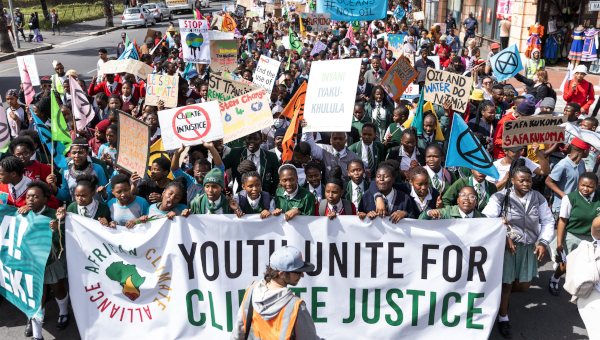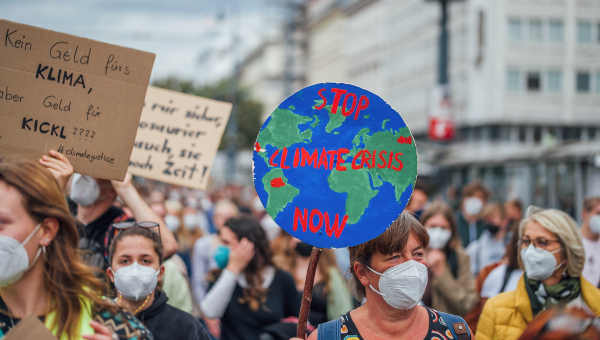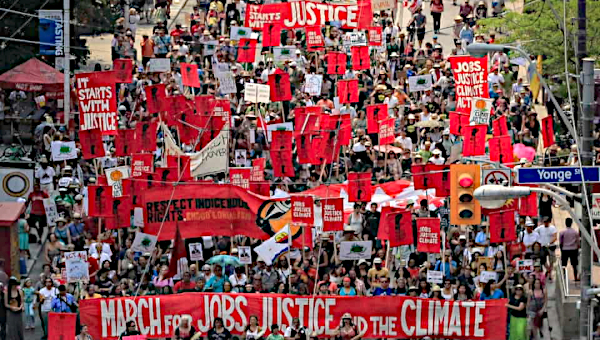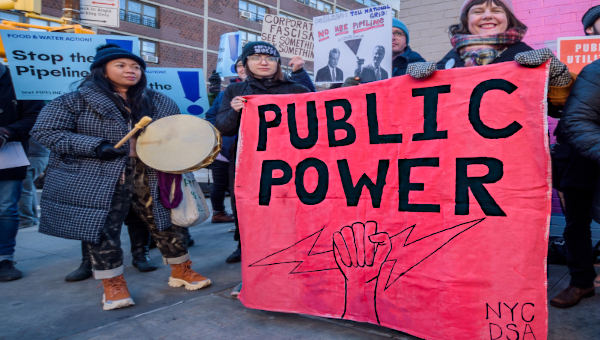The September 21 People’s Climate March in New York City was a huge success. Over 310,000 people consisting of hundreds of contingents of various origins and interests marched in New York (some have put the number of marchers as high as 400,000). The organizers report that 2,807 similar actions took place in 166 countries during that weekend. In New York, contingents representing environmentalists, trade unionists, students and youth, indigenous activists, community organizations, religious and political groups and many others represented the breadth of support for immediate effective action to stop and reverse global warming and catastrophic climate change. Although dozens of similar protests took place elsewhere in the U.S., thousands of participants came to New York on 550 buses, many trains and planes to give the march a national character.
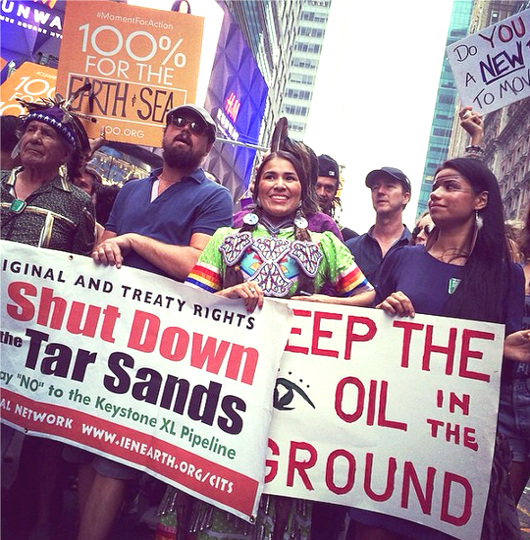 Also, the march had an international character because it was in response to the UN September 23 meeting of heads of state and corporate leaders to address climate change. It is not secret that only an internationally coordinated response can successfully address climate change. Among marchers there was not just high-profile environmentalists like Bill McKibben of 350.org, Leonardo DiCaprio, Jane Goodall and Vandana Shiva but also key politicians including U.S. Senators Sheldon Whitehouse (D-R.I.), Bernie Sanders (I-Vt.) and Charles Schumer (D-N.Y.), New York Mayor Bill de Blasio and former U.S. Vice-President Al Gore. UN Secretary-General Ban Ki-moon also joined the March. President Barack Obama sent a supporting Twitter message. While mainstream media did not cover the march in proportion to its importance there was positive coverage of it in the New York Times and other influential mass media.
Also, the march had an international character because it was in response to the UN September 23 meeting of heads of state and corporate leaders to address climate change. It is not secret that only an internationally coordinated response can successfully address climate change. Among marchers there was not just high-profile environmentalists like Bill McKibben of 350.org, Leonardo DiCaprio, Jane Goodall and Vandana Shiva but also key politicians including U.S. Senators Sheldon Whitehouse (D-R.I.), Bernie Sanders (I-Vt.) and Charles Schumer (D-N.Y.), New York Mayor Bill de Blasio and former U.S. Vice-President Al Gore. UN Secretary-General Ban Ki-moon also joined the March. President Barack Obama sent a supporting Twitter message. While mainstream media did not cover the march in proportion to its importance there was positive coverage of it in the New York Times and other influential mass media.
Still, it is doubtful if many participants returned home thinking that the U.S. and world elites have heard their message and will now collaborate on a plan to slow and then stop emission of greenhouse gases in a timely fashion. Two-decades of fruitless international ‘negotiations’ have made any thinking person skeptical about the intentions of capitalist politicians and corporate leaders who are after their own narrow self-interests rather than the health of the planet and its peoples. The key accomplishment of these protests was the broad collaborative effort of many constituencies who are serious about putting an end to greenhouse emissions and address other planetary crises and the message they sent to the rest of the people of the world. We can build on the success of this march and similar events to continue bottom up pressure for change in climate and public policy in the U.S. and worldwide. To this end, I will take up a few lessons from our recent experience.
‘Left-wing’ Criticism of the People’s Climate March
There was considerable hesitancy on the part of some socialist organizations and personalities to embrace the opportunity to build the climate actions called for by the organizers of the New York march. In Oakland, California, where a very successful rally of 4,000 was held on the afternoon of September 21, some socialist organizations in the System Change Not Climate Change local coalition that initiated the process were hesitant to work with ‘reformist environmentalist groups’ like 350.org and Sierra Club. Some even did not think a successful event can be organized because they knew the local socialist groups have little political influence to bring in a crowd and they already excluded working with environmentalist groups in their minds. It took a lot of discussion for almost everyone to be convinced that (1) a successful event can be organized and (2) it is not only OK to work with ‘reformist environmentalist groups’ but it is imperative that we do so.
A similar attitude was expressed toward the main event in New York. Chris Hedges (some of his articles I really like) wrote an article for truthdig.org on August 30 entitled “The Last Gasp of the Climate Change Liberals.” He said:
“Our only hope comes from radical groups descending on New York to carry out direct action, including Global Climate Convergence and Popular Resistance. March if you want. But it should be the warm-up. The real fight will come once people disperse on 11th Avenue.”
Thus, he counterposed the massive People’s Climate March (which he estimated in his article to be about 200,000) to the “radical” action on the following day that happened to bring together 3,000 to stop the traffic in Wall Street area and lay the blame for climate change on “capital.”
Anne Petermann, who had already criticized the organizers of the march earlier for lacking any demands, wrote in Climate Connections on the eve of the march an article entitled “Confronting Climate Catastrophe: Direct Action is the Antidote for Despair; Or, Why the UN is Worse than Useless and we need to Flood Wall Street!” She too counterposed the mass march of well over 300,000 people to the “direct action” of 3,000.
Clearly, Hedges and Petermann have proved wrong. Few people anywhere in the world would hold that the Flood Wall Street action of 3,000 people was the main show and the People’s Climate March of over 300,000 a mere side-show.
Petermann has also proved wrong about a lack of demand – nobody else seems to be in doubt what the main demand of the marchers was: STOP CATASTROPHIC CLIMATE CHANGE NOW! Unless, of course, Petermann wants the marchers to agree on a plan of action on how to carry this demand to a successful conclusion!
Socialist groups who finally poured their energy into building the very successful rally in Oakland have no doubt that working alongside the environmentalist groups was key to its success. They too have come out of this experience stronger.
‘Gasps of despair’ better exemplifies the state of individuals and organizations that either sat outside of these mass events or counterposed to them ‘radical’ actions of the ‘enlightened’ few.
It does seem that the meaning of ‘direct action’ is muddled in the discussion, no doubt due to decades of very low levels of mass struggle in the United States. Lessons of anti-Vietnam war and civil rights movements in the U.S., not to mention lessons from the world revolutions seem to have been entirely lost to some, including Hedges and Petermann. In the revolutionary socialist and labour movements, the concept of ‘direct action’ was never severed from mass action. The reason is simple – radical social change can never be the work of any elite group’s action. Only the working people can change the course of history. And the fight against climate change is nothing less than changing the course of history.
What About the Flood Wall Street March?
How about the Flood Wall Street march of 3,000 that happened on Monday September 22? In “What Is Wrong With the Radical Critique of the People’s March” in The Nation, Jonathan Smucker and Michael Premo correctly criticize Hedges’ ultra-left sectarian position. As participants in both People’s Climate March and Flood Wall Street march they correctly argue:
“What Hedges overlooks is how easily direct acts of revolt can be dismissed or repressed, if they are carried out by a small number of people who are not visibly tied to a broader social base. This is why Flood Wall Street’s mobilization in relation to the PCM (People’s Climate March) was so vital.”
I think Smucker’s and Premo’s article is an excellent contribution to the discussion among socialist and ecological socialists involved in the movement to stop catastrophic climate change and I urge everyone to read it carefully. However, I also wish to add a note that the so-called “escalated tactics” of the Flood Wall Street march could not have served the movement well because it was not a mass march contrary to the idea of “flooding” in the name of it. It remained an elite action because it would have been much larger even if only the communities that organizations represented participated in it. Furthermore, blocking the traffic and holding “capital” responsible for climate change do not advance our movement. Raising consciousness and organizing on a daily basis do. And I submit the latter is much harder to do than the former – to patiently explain, educate, agitate and organize. These will require close collaboration with many other groups currently led by reform-minded leaderships, especially the environmental groups, especially 350.org. The bulk of those who came to the People’s Climate March came because of the work of these organizations and that is more reason why instead of “escalating tactics” we need to spend more time working with them building future protests. •
This article first appeared on forhumanliberation.blogspot.ca.


